Table of Contents
Most agencies — especially smaller agencies (<$1M ARR) — have a pricing problem.
You might not realize that if you’ve had a few decent quarters and keep closing deals.
Project pricing usually comes down to a gut feeling or seeing what others are charging and pricing the same. Founders often balance two conflicting demands: How much do we need this month/quarter vs. what do I think this client can afford?
In most cases, agency founders get pricing wrong.
Broken pricing models causes a whole cascade of problems for your agency:
- Poor margins due to undercharging for work
- Poor margins due to improperly scoped work, which causes you to do additional [unpaid] work
- Inability to hire the right team to deliver services
- Inability for the founder to pull themselves out of service delivery
Broken pricing is generally consequence of spending too much time looking outside (at competitor pricing) and not enough time looking at your own numbers.
This article will review every agency pricing method available to you, and break down the pros and cons of each.
At the end, I’ll detail the pricing system I recommend based on by 10+ years of building, scaling and selling agencies.
Complete List of Agency Pricing Models
1. Fixed fee pricing
What is it?
Flat fee pricing charges a flat amount for your service. I generally look at this as an ongoing scope / engagement (i.e. monthly fee), not a one-off engagement.
I remember when I was just getting started and I was just throwing out numbers – $500, $300, $1000 per month – based on what I thought our services were worth.
A lot of agencies start here because it’s simple to quantify, both from an agency management and client understanding perspective.
Examples:
- $500 / month for SEO
- $300 / per content published
- $1,000 / month for ads management
How is it calculated?
I’ve seen a lot of young agencies calculate this based on what they believe their service is worth market pricing or competitors – just like I did.
What’s so wrong with that? It should be built based on projected number of hours to complete a given task. If it’s not, it exposes you to scope creep.
$ = (Hours required x Hourly rate) x Desired margin
$ = (10 hours x $100/hr) x 40%
$ = $1,400
- Good for small, young agencies
- Easy to justify to a prospective client
- Good for prospects with a set budget
- Estimates can become inaccurate quickly, leading to massive scope creep
- Disincentives an agency to find new growth opportunities for a client
- Not a good method to grow larger engagements and scale your agency
What is scope creep?
Scope creep occurs when you consistently do work for a client that’s outside the agreed upon scope of work. Scope creep is a killer – it creates more work (that you’re not compensated for), headaches and staff discontent. Scope creep MUST be avoided at all costs!
2. Project based pricing
What is it?
Similar to flat fee pricing, but focused on short term campaigns or deliverables.
Examples:
- $5,000 for a technical audit
- $2,000 for a set of blog posts
- $500 / page for web design
How is it calculated?
Similar to fixed free pricing, with the assumption that it will be a one time scope of work.
$ = (Hours required x Hourly rate) x Desired margin
$ = (1 hour x $100/hr) x 40%
$ = $140
- Good opportunity get foot in the door (i.e. run an audit, then upsell full scope)
- Works well for design and development where there’s a finite end to a project
- Works well when you work fast (i.e. a logo) and produce high quality results
- Can be major issues with scope creep that erodes your profitability on the deal
- If you don’t have a sales person managing the relationship, it can be a lot of effort for not a lot of revenue. Upselling these projects is key!
3. Value based pricing
What is it?
Where work is priced based on the “value” it delivers to the client as opposed to the agency’s time, costs, margins, etc.
It can be viewed as the price clients are willing to pay for your services based on the value brought.
To me, this means you need something unique about your service.
This is an unpopular point of view – mainly because people confuse Value Pricing with Performance Pricing.
Value Based pricing does NOT mean you get paid based on the “value driven by your services”, that would be Performance Pricing. Value pricing is based on the PERCEIVED VALUE that your services can add, not the ACTUAL RESULTS VALUE of your services.
If you’re really interested in this one, I strongly recommend watching the video at the top of this page. I breakdown Gary Vee and his Value Based pricing model at about the 6-minute mark.
Examples:
- Additional value brought from having someone like Gary Vee (or relevant influencer) on staff. Having that level of intellect in house will command additional value in engaging with your agency.
- Additional value brought from having proprietary software in house that the market can only get access to if they become an agency client. Having this software ONLY available to clients commands additional market value for that client.
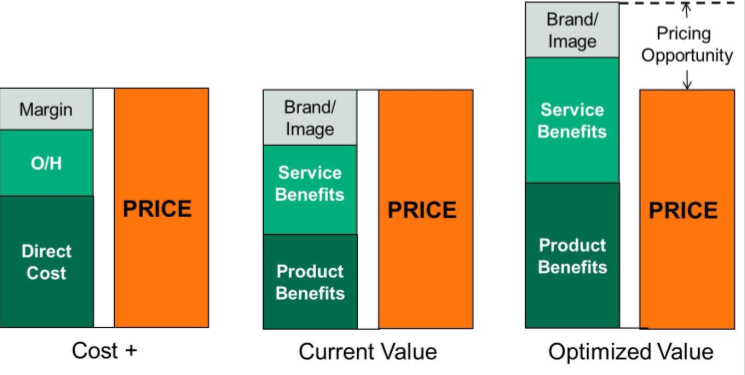
How is it calculated?
Pricing is calculated based on the customer’s perception of value AND the value you determine you can bring to a client campaign. They need to align to strike a deal.
There is no mathematical way to calculate perceived value. Instead, you should focus on your justification for the additional value you bring.
- Works well if you have a lot of clout and demand, value can be derived
- Can have huge margins if sold
- Value is difficult to define and subjective
- Slows down the process by having to constantly convince prospects of your “value”
- Still doesn’t reduce scope creep
- Need to have proprietary advantage in the market over competitors
Want more on agency pricing models / trends? Check out Credo’s industry pricing survey.
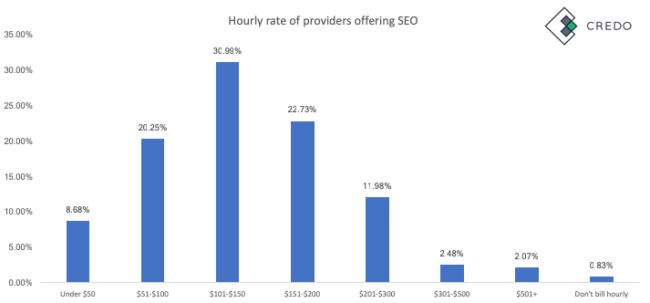
4. Performance based pricing
What is it?
When your agency is compensated based on the output of your work. For example, if you’re working with an attorney running PPC ads. Every time you drive a phone call, you get paid.
Examples:
- $500 each phone call driven
- 15% of each sale made as a result of services
- 5% equity stake in the business based on X milestones hit
- Free until you rank for “boner pills KW”
How is it calculated?
You need to make sure you’re tracking the right things in Analytics / CRM closely, as you’ll be compensated based on the results you drive.
- Set a fixed price ahead of time per lead, visit or sale
- Charge for each as they are accrued in real time
- Clients are always happy to pay per result
- Can be highly profitable if you can dial in the arbitrage right
- There’s a lot of work that goes into driving results (months)
- Results are never guaranteed
- Client has all the advantage here
5. Retainer based pricing
What is it?
When a client agree to a pre-negotiated and pre-paid fee for either a set amount of time, or a set number of deliverables.
Examples:
- $5k/month for 50 hours of SEO work
- $5k/month for 4 posts a day on each social platform, create 20 images, respond to 100 comments, etc
How is it calculated?
You need to forecast the number of hours it will take to deliver work across the entire agreement. You can do this by building detailed hourly forecasts during the proposal phase and sum / amortize these into monthly retainers.
Service
| Month 1 | Month 2 | Month 3 | |
| Technical SEO | 10 | 10 | 5 |
| Content audit | 0 | 20 | 0 |
| Keyword research | 5 | 5 | 5 |
| On page SEO | 0 | 0 | 20 |
| Total Hours | 15 | 35 | 25 |
- With hours projected, you can simply multiple that times your hourly rates to determine monthly cost
- You can either amortize the total number of hours of bill actuals as they accrue
- Clients like retainers because it helps them budget easier (no variable costs)
- Easy to track and manage if you’re tracking hours internally
- Easy to pitch and justify to a prospect
- Paid up front
- Easy to scale
- Mismanaged hours will cause HUGE issues with profitability and scope creep
6. Points based pricing
What is it?
Each project within a campaign is assigned a fixed-point total based on value creation rather than hourly estimates.
Point allocations are defined at the start of every month, and are based on an agreed-upon scope. This allows for more efficient and accurate forecasting and planning.
Examples:
- 20 points of work each month = 3 points for a blog post (4/month) and 4 points for email blast
How is it calculated?
Point allocations are defined at the start of every month, and are based on an agreed-upon scope.
Points are roughly based on hours to complete work x desired margin. You need to create an entire scale of this to pitch to clients.
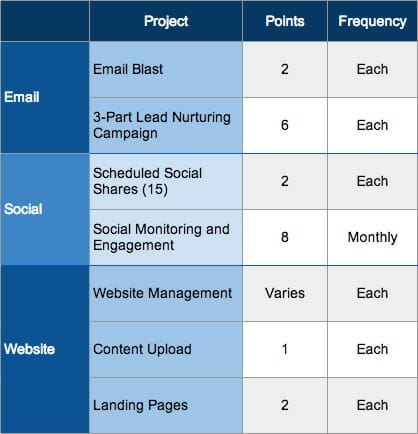
Graphic source
- Set a fixed price ahead of time per lead, visit or sale.
- Charge for each as they are accrued in real time.
- It’s easy for clients to pick the work they want
- You’re able to easily meet expectations
- Regardless of how much time is invested to complete each project, the point totals remain constant (scope creep)
- Becomes a lot of ongoing work to manage points
- Creates more work (comms) and you become an “on demand” vendor, almost outsourced
- Convoluted and confusing, slows down sales process
7. Hourly pricing
What is it?
The client pays for your staff’s time, by the hour. Generally speaking, hours are sold with minimums or in monthly retainers.
Examples:
- 10 hours of on page work month 1, 10 hours of keyword research month 1 and 2
How is it calculated?
Hourly (aka billable rates) are assigned to each employee.
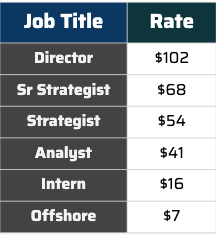
- Please watch this video on how to find your hourly pricing for your agency’s employees.
The BEST Agency Pricing Model(s)
The truth is, your pricing should be fluid. Meaning, you’re always looking to improve it as your agency grows.
We’ve outlined 3 pricing models that we recommend based on your agency’s revenue path.
#1: Hours-based, Value-influenced Pricing (HBVI)
HBVI pricing is based on 2 inputs:
- Your internal costs to deliver the service
- Desired profit margin based on the impact of your services (i.e. doubling traffic will amount to $x in sales)
Let’s use a non-agency example, as it’s easier to understand this pricing model.
Imagine you’re a business that makes computer mouses. You’d likely price your mouse based on the cost to make the mouses (materials, labor, etc).
Once they know their costs, they add a markup depending on:
- How much profit they want to make (factoring in the volume you need to sell to break even)?;
- Whether they can sell the added value/features-based benefits (such as whether it’s wireless, etc.);
- How much are customers willing to pay.
In the retail world, this is called cost plus pricing.
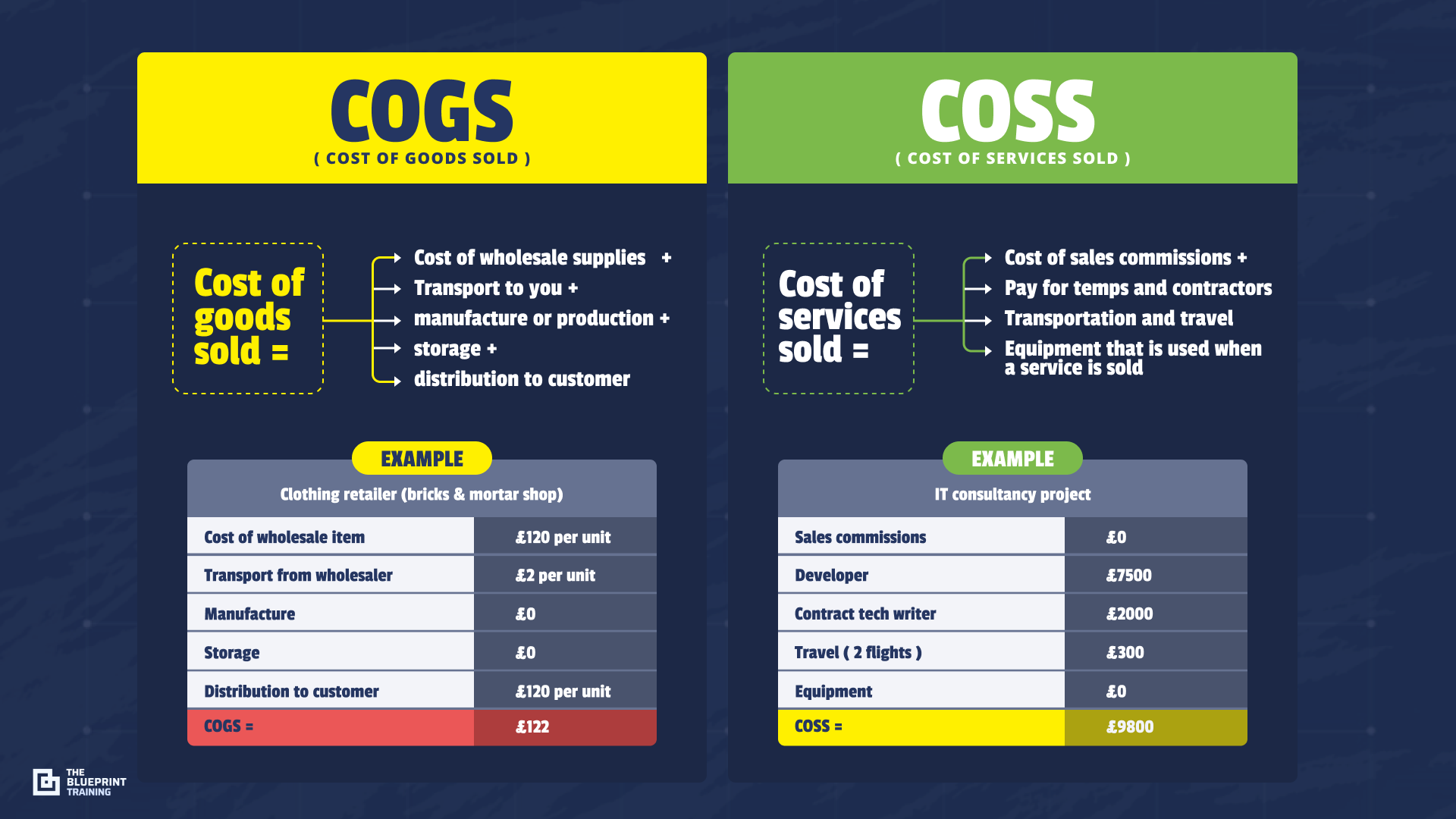
HBVI pricing is the same as cost plus pricing, just applied to agencies.
HBVI forces you to understand your numbers and think through your impact with clients. What you end up with is a pricing model that guarantees a certain level of profitability.
Let’s quickly walk through how to calculate HBVI pricing.
Step 1: Find your hourly rate
The only way this truly works is by tracking your team’s time. You have to understand how much it costs the business to deliver your services.
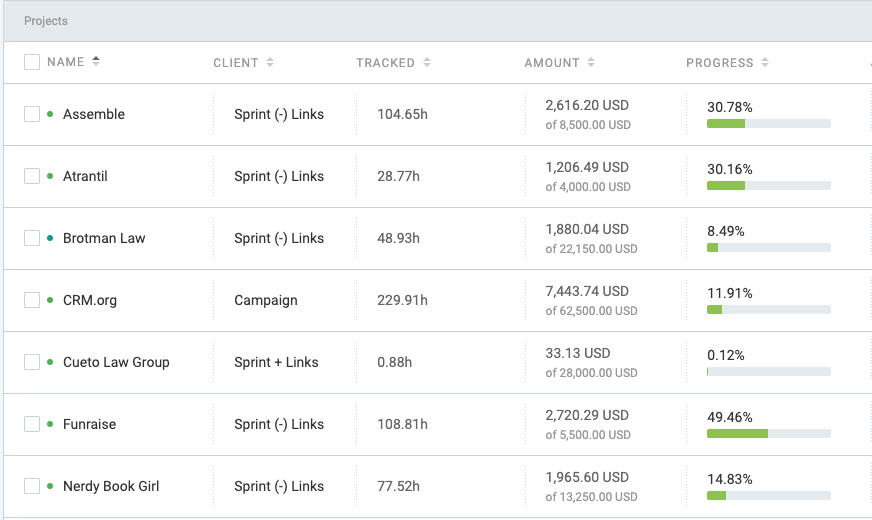
Don’t limit costs to staffing/freelancers. Take every cost into account, everything that goes into delivering your service.
- Software costs
- Office costs, if you have one
- Travel (if applicable)
- Cost of labor
Divide this new total by the number of working hours in the year (12 working months / weeks / days – time for annualized employee holidays, fixed holidays, e.g. Thanksgiving, Christmas, etc).
Now you know the actual cost of delivering client work, with an accurate hourly rate.
Step 2: Project the number of hours
With this more accurate hourly rate — and time tracking — you will finally know what it costs to deliver client work.
It doesn’t matter whether a project is 10 or 100 hours. This cost is now fixed.
Once this is clear, load the minimum profits you want/need to make — as a founder, or team of co-founders/directors — into the hourly rate.
Step 3: Tack on desired margin
Now you can front-load higher margins based on the value-based impact of your agency’s work. Here’s how you do this:
- Let’s assume the actual cost of delivering client work is $3k for 30 hours. As a founder, you want to make $500 profit on this project.
- Now factor in the value-influenced impact. If the revenue increase is 10%, you could charge 10% of the ROI, and bake that into the project/monthly price.
- With a 10% increase on $500k revenue, a client will generate an extra $50k because of your work.
- Charge $5000 more and divide that by the number of months a project runs.
Most founders worry about whether clients can afford higher prices. You solve that problem by knowing your clients inside and out, particularly pain points, revenue models, and budgets.
Charging more is also easier to justify when the impact outweighs the costs.
#2: Project-based, Tripwire Pricing (Small ticket, Big upsell)
Project-based, Tripwire Pricing (PBTW) is a great way to sell something small, low value, to upsell bigger ticket services.
Factor in everything I talked about above. Have a clear handle on your costs and value-influenced impact, to price bigger ticket retainer or project-based services.
That’s your goal. Use a small ticket offering to upsell services that make real money.
You see this a lot in the “internet marketing” world. A low cost offer that establishes a relationship with the customer, making it easier to sell higher ticket offers down the line.
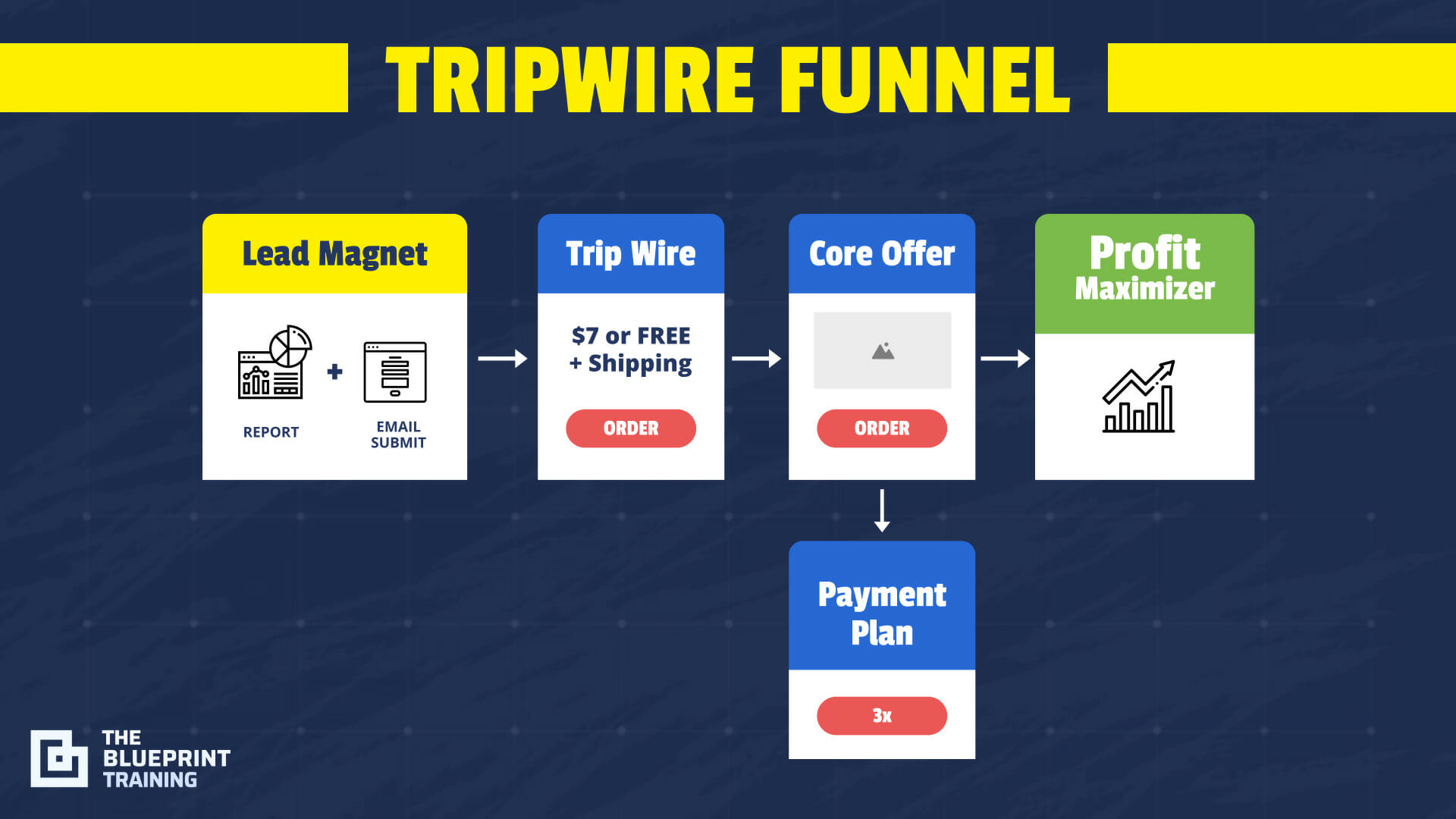
Most agencies can spinoff smaller products/services that generate enormous value for clients. Services such as:
- SEO agencies can sell Website Quality Audits (WQA)
- Content marketing playbooks
- SEO and keyword competitor analysis
- Template-based eCommerce sites (on Shopify)
- Low-cost, template-based websites/micro sites
Sell these at-cost, or only making a marginal profit. Make them easy to sell, compelling, and affordable. So affordable that you can take card details/payment on a single call.
Then deliver enormous value in a short timescale. Impress the client. Do another call, and use this to upsell ongoing, bigger ticket services.
We do this at WEBRIS, with SEO Sprints™, to upsell Content and Link Sprints. 60% of clients buy ongoing services, and 80% come back after one sprint. Even though we aren’t selling retainers, clients value the impact of our work and keep coming back.
You can do the same. Low-ticket services are a very effective way to make an impact quickly. Give clients a compelling reason to keep working with you long-term.
#3: Impact/Value-based Pricing (IVB)
Impact/Value-based Pricing (IVB) is more effective for agencies that generate outsized proven impact. Generally, this works for larger agencies, coaches and consultants that add enormous value for enterprise clients, or high-net worth individuals.
Examples of this are:
- Agencies that generate at least $10M+ revenue upticks for clients
- Consultants that increase clients’ revenue $1M+
- Training — such as The Blueprint Training program — that increase revenue anywhere between $20k and $100k+
When you are making that kind of impact for clients with decent budgets, you can charge anywhere between $100,000 and $1 million for your services.
IVB pricing allows you to charge the maximum amount without increasing workloads. It completely removes the “hours for work” model from your prices.

IVB pricing works for agencies, coaches and consultants who are making a massive impact and want to take the leap to higher revenue and profits.
Test the market with one or two new clients. Charge what you think is justifiable in the context of your impact, and the clients budget. Keep doing that until you finally get market pushback.
There’s a good chance you’ve been undercharging for a while now.
Key Takeaways: How to fix your agency’s pricing?
Agency pricing is broken. It keeps your margins and profits low. Most agencies have this problem. And in most cases — even if you don’t fix anything else — it’s fixable.
Here’s the 3 pricing models you could implement instead:
- Hours-based, Value-influenced Pricing (HBVI). Factor in the total actual cost of delivering services, plus the profits you want to make, and add the value-impact of your agency’s work.
- Project-based, Tripwire Pricing (PBTW) is a small ticket, big upsell model. Offer a low-cost, small ticket deliverable as a psychological gateway offering to bigger ticket, ongoing services.
- Impact/Value-based Pricing (IVB). For agencies and consultants that make a huge impact, you can start pricing accordingly.
Are you ready to fix your pricing, positioning, and service delivery?
We can help you do that. Book a time to talk to a growth advisor about how we can work 1 on 1 to grow your agency.